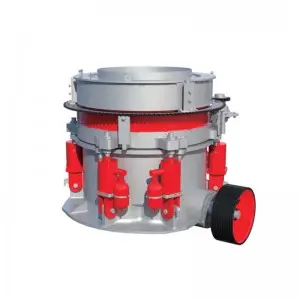In the fields of mining and construction crushing, the iteration of equipment has always revolved around the three core aspects of efficiency, safety and adaptability. In recent years, with the maturation and popularization of hydraulic technology, the application proportion of hydraulic cone crushers in various crushing scenarios has continued to rise, gradually changing the market pattern dominated by traditional spring cone crushers. This transformation not only stems from technological progress but also conforms to the dual demands of modern industry for efficient production and safety management.
From the perspective of structural principles, the most significant difference between the two lies in the overload protection mechanism. The traditional spring cone crusher relies on the spring group to achieve buffering and resetting of the crushing chamber. When encountering unbreakable objects (such as iron blocks), the discharge port will be passively expanded to expel the foreign objects. The recovery process requires manual adjustment of the spring preload force, which is not only time-consuming but may also affect the subsequent crushing accuracy due to improper operation. The hydraulic cone crusher is automatically regulated through a hydraulic system. When the equipment is overloaded, the hydraulic cylinder will quickly push the moving cone to retreat. After the foreign objects are discharged, it can precisely return to its original position under the action of hydraulic oil. The entire process does not require manual intervention, and the average processing time is shortened by more than 60% compared to the spring type, significantly reducing downtime losses.
The improvement of production efficiency is the key factor for the hydraulic cone crusher to gain favor. The variable pump hydraulic system it is equipped with can automatically adjust the crushing force according to the hardness of the material. When processing hard rocks such as granite and basalt, it can maintain a stable crushing frequency. Through the optimized design of the crushing cavity type, the qualified rate of the finished product particle shape is increased by about 15% to 20%. Meanwhile, the hydraulic-driven adjustment device keeps the discharge port adjustment accuracy within 0.1mm, enabling a rapid response to the switching of different particle size requirements. This means greater production flexibility for aggregate production lines that need multi-specification finished products. Data shows that under the same power configuration, the processing capacity per unit time of the hydraulic cone crusher is on average 12% higher than that of the traditional spring crusher, and its advantages are more obvious in continuous operation scenarios.
The optimization of maintenance costs should not be ignored either. The spring assembly, adjustment ring and other components of the spring cone crusher are constantly in a high-frequency vibration state, resulting in a relatively fast wear rate. On average, a comprehensive inspection is required every 1,500 hours, and when replacing components, the entire unit needs to be disassembled. The maintenance cycle is usually 8 to 12 hours. The hydraulic system adopts a closed design. The service life of key components such as hydraulic valves and seals can reach over 3,000 hours. Combined with an integrated lubrication system, daily maintenance only requires regular checks of oil levels and filter element conditions. More importantly, modern hydraulic cone crushers are generally equipped with intelligent monitoring modules, which can provide real-time feedback on parameters such as oil temperature and pressure, issue early warnings of potential faults, and reduce unplanned downtime by more than 40%.
The upgrade of security performance is also an important reason driving the trend of substitution. When overloaded, the spring may break and the adjustment ring may fly off, posing safety hazards. The hydraulic system achieves multi-level protection through pressure sensors. When the pressure exceeds the threshold, it will automatically shut down, and in combination with the emergency braking device, the accident rate is kept at an extremely low level. In addition, the hydraulic cone crusher has a higher degree of automation and can be remotely operated through a PLC control system, reducing direct contact between personnel and equipment. It is particularly suitable for use in harsh environments with heavy dust and high noise.
Of course, technological iteration is not achieved overnight. Spring cone crushers still have certain application space in medium and small-scale production lines. However, with the gradual decline in the cost of hydraulic components and the improvement of the second-hand equipment market, the cost-performance advantage of hydraulic cone crushers is continuously expanding. From the perspective of industry development trends, this substitution process is not merely a change in equipment types, but also represents the transformation of crushing operations towards intelligence and greenness – lower energy consumption, higher resource utilization, and a safer working environment. These are precisely the core goals pursued by the modern crushing industry.
For operators of crushing operations, understanding the logic behind this technological substitution not only helps them make more reasonable equipment choices but also enables them to make early plans to adapt to future production models. The popularization of hydraulic cone crushers might just be an important sign that the crushing industry is moving towards a new era of efficient production.

Post time: Oct-15-2025
